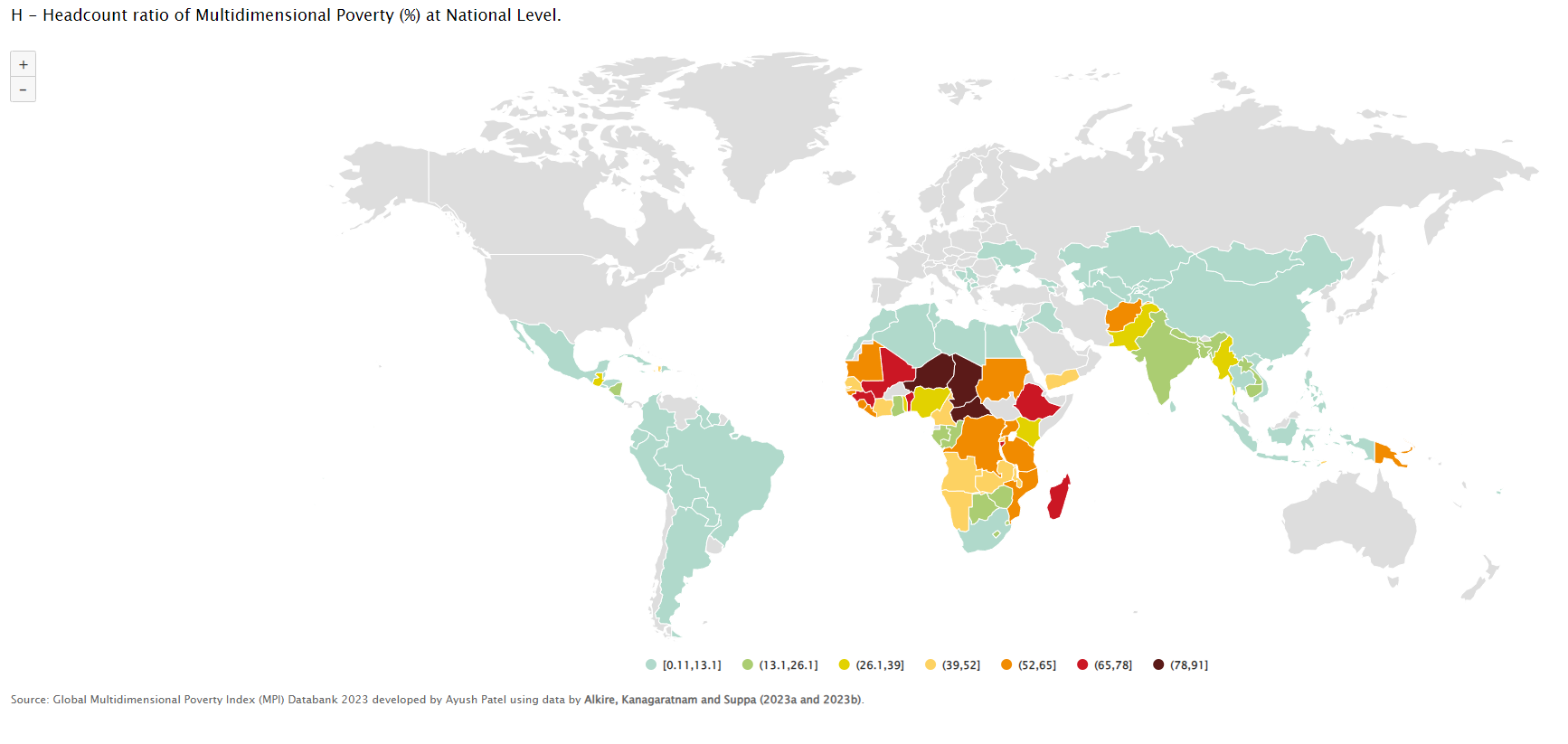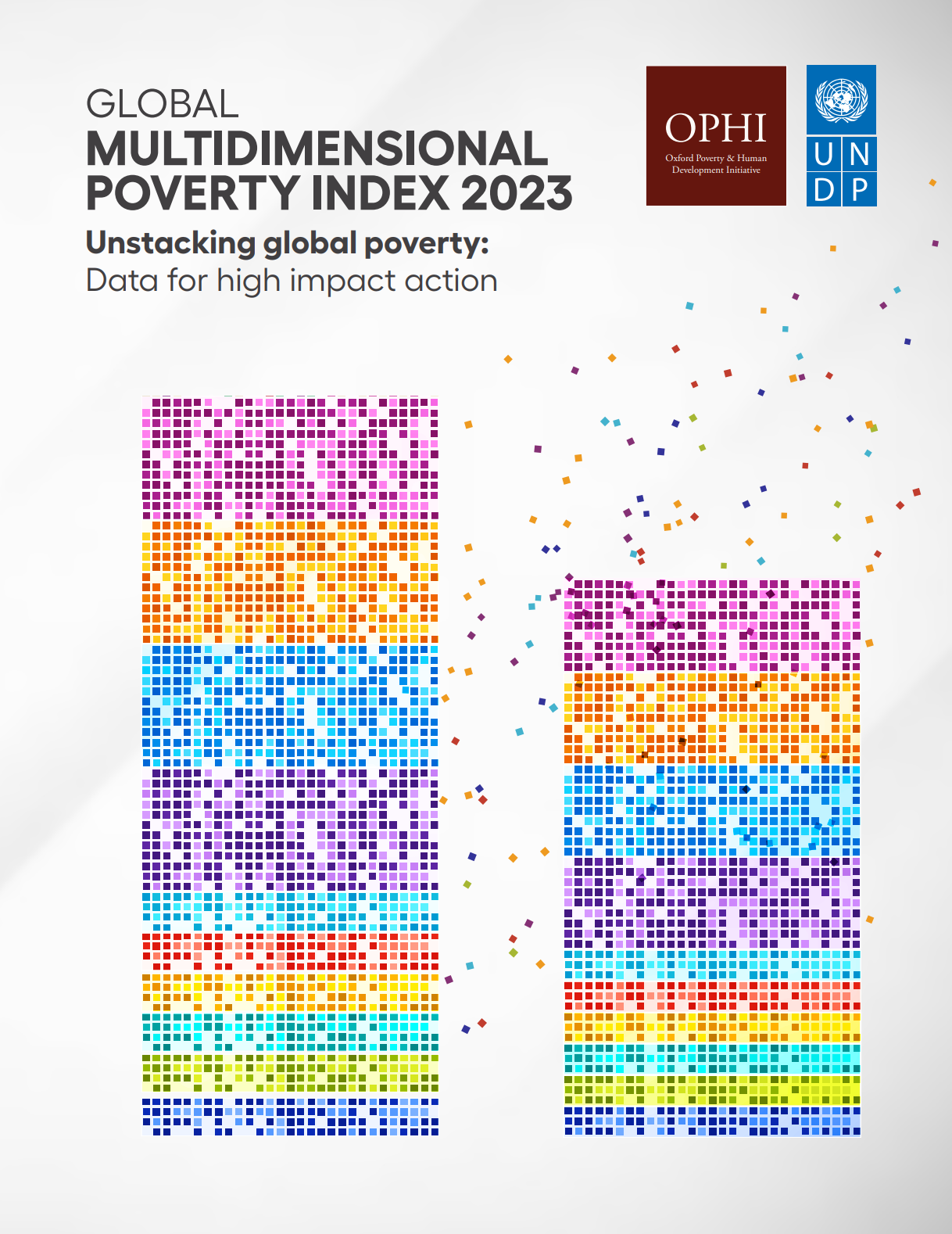Global MPI 2023
The 2023 global Multidimensional Poverty Index (MPI) uses the most recent comparable data available for 110 countries—22 low-income countries, 85 middle-income countries and 3 high-income countries. These countries are home to about 92 percent of the population in developing regions. Global MPI values, incidence and intensity of poverty, and component indicators are disaggregated for 1,281 subnational regions as well as by age group, rural-urban area and gender of the household head. In Table 6, we publish harmonised estimates for 84 countries, which provide results for trends over time. Forty-five of the 84 countries have trends for two points in time, 35 countries have trends for three points in time, while four countries have trends for four points in time.
Our joint report
This year’s report Unstacking global poverty: Data for high-impact action, produced in partnership with the United Nations Development Programme Human Development Report Office (UNDP HDRO), presents a compact update on the state of the world’s multidimensional poverty. It compiles data across 110 developing countries covering 6.1 billion people and accounting for 92% of the population in developing countries. It tells us an important and persistent story about how prevalent poverty is in the world, and provides insights into the lives of the poor, their deprivations and how intense their poverty is – to inform and accelerate efforts to end poverty in all its forms. As few countries, still, have post-pandemic data, the report also calls insistently for updated multidimensional poverty data. While the report provides a sobering annual stock take of global poverty, it also highlights examples of success in every region.
- Citation: OPHI (Oxford Poverty and Human Development Initiative) and UNDP (United Nations Development Programme) (2023). Unstacking global poverty: Data for high-impact action. United Nations Development Programme and Oxford Poverty and Human Development Initiative.
Our data
The global MPI results are presented in eight Data Tables. Data Table 1 presents MPI country (national) results using the most recent data from 110 countries, covering 6.1 billion people. The country (national) estimates are jointly produced by OPHI and UNDP’s Human Development Report Office (HDRO). Please refer to OPHI MPI Methodological Note 55 for the core methodology and country specifications.
In addition, the OPHI team produces an additional set of Data Tables (Tables 2–8). These include selected auxiliary statistics, namely, standard errors of key estimates consistently. Data Table 2 presents estimations for multiple poverty cut-offs as a measure of robustness. The MPI and its partial indices are also disaggregated by several different population groups: age groups (Data Table 3), rural and urban areas (Data Table 4), subnational regions (Data Table 5) and gender of household head (Data Table 7). The disaggregated MPI results shared in these tables show the importance of going beyond national averages to identify important variation across population groups. Please refer to OPHI MPI Methodological Note 56 for OPHI’s disaggregation methodology and policies.
Data Table 6 presents trends over time in 84 countries. For 35 of these countries there are trends for three points in time, while four countries have data for four points in time. Data Table 6 also contains disaggregated results of the extent to which poverty has changed over time for age groups, rural and urban areas, and for 814 subnational regions. Please refer to OPHI MPI Methodological Note 57 for trends over time methodology and country harmonisation details.
Finally, Data Table 8 presents all global MPI country (national) results published since 2010.
Oxford Academic Licence
Our Country Briefings
Documentation
The OPHI MPI Methodological Notes series is a technical paper series that provides details of the global MPI methodology and transparently documents the decisions made for each country dataset. A MPI Methodological Note is published for every global MPI release. MPI Methodological Notes are published with an accompanying set of data tables and, starting from 2018, Stata do-files.
Technical files
Our data preparation do-files allow you to generate the global MPI indicators from the microdata. This is the first technical step. Microdata are household surveys produced by specific survey providers such as DHS and MICS.
The technical files (or Stata do-files) for each country survey can be downloaded below. Please refer to OPHI’s Methodological Note series for information on survey details.
The do-files used for the purpose of generating the global MPI indicators are open access under the Oxford Academic licence.
Do-files as a zip package
The global MPI estimates are produced using the Stata package `mpitb` by Nicolai Suppa. For more information visit this paper. This is the second technical step. The package produces estimations by national, by population subgroups, e.g.: age groups, rural and urban areas, subnational regions and supports the estimation of levels and change between time periods. `mpitb` simplifies estimations and analyses in cross-country settings.
The package is available at the Statistical Software Components (SSC) Archive and on gitlab. The MPI toolbox is distributed free of charge under an MIT license. The package may be installed by issuing `ssc install mpitb` in Stata. To access its comprehensive help files issue `help mpitb` after the installation. `mpitb` requires Stata 16 or higher.
Download the technical files (or Stata do-files) for each country survey
Our Interactive Databank

Browse through our databank to view the global MPI 2023 data in different ways and use it in briefings, teaching or presentations. This web application allows the user to explore the GMPI data through interactive graphics. Users can see the spatial spread of multidimensional poverty, its intensity and headcount. The application presents comparisons at global and country and subnational level.
Source: Global Multidimensional Poverty Index (MPI) Databank 2023 developed by Ayush Patel using data by Alkire, Kanagaratnam and Suppa (2023a and 2023b).



